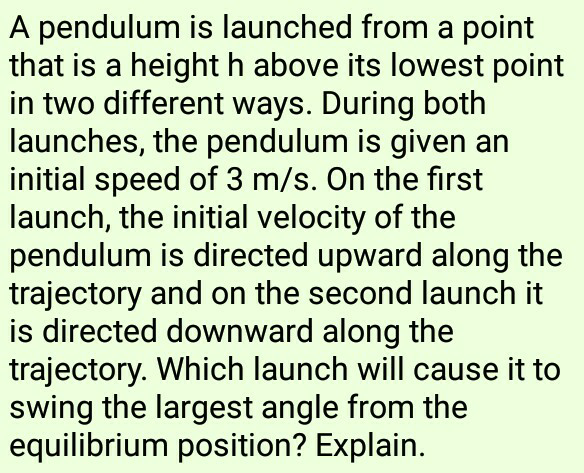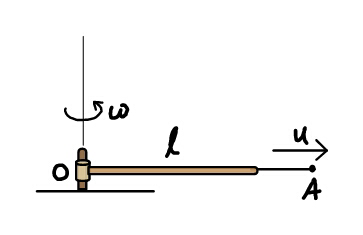
Question and Answers Forum
OthersQuestion and Answers: Page 125








Pg 120 Pg 121 Pg 122 Pg 123 Pg 124 Pg 125 Pg 126 Pg 127 Pg 128 Pg 129
|
Question and Answers Forum |
OthersQuestion and Answers: Page 125 |
| If three positive numbers a, b, c are in A.P. and (1/a^2 ), (1/b^2 ), (1/c^2 ) also in A.P., then (1) a = b = c (2) 2b = 3a + c (3) b^2 = ((ac)/8) (4) 2c = 2b + a |
| A rigid body is made of three identical thin rods, each of length L, fastened together in the form of letter H. The body is free to rotate about a horizontal axis that runs along the length of one of legs of H. The body is allowed to fall from rest from a position in which plane of H is horizontal. The angular speed of body when plane of H is vertical is |

|
| A particle of mass m is moving in yz-plane with a uniform velocity v with its trajectory running parallel to +ve y- axis and intersecting z-axis at z = a. The change in its angular momentum about the origin as it bounces elastically from a wall at y = constant is : (1) mvae_x ^∧ (2) 2mvae_x ^∧ (3) ymve_x ^∧ (4) 2ymve_x ^∧ |
| The ratio of acceleration of points A, B and C is [assume all surfaces are smooth, pulley and strings are light] |
| A particle is suspended vertically from point O by ideal string of length L. It is given horizontal velocity ′v′. There is vertical line AB at a distance (L/8) from P. At some point, it leaves circular motion and follows projectile motion. At the instant it crosses AB, its velocity is horizontal. Find u |
| Consider a uniform square plate of side a and mass m. The moment of inertia of this plate about an axis perpendicular to its plane and passing through one of its corners is |
| A 2.2 kg block starts from rest on a rough inclined plane that makes an angle of 25° with the horizontal. The coefficient of kinetic friction is 0.25. As the block goes 2 m down the plane, the mechanical energy of the Earth-block system changes by |

|

|
| solve ∣x^2 −4x−5∣=7 |

|
| Calculate the electric potential at a point P at a distance of 3m of either charges of +20 μC and − 15μC. which are 25cm apart. Also calculate potential energy of a +3.5μC placed at point P. |
| The density of a non-uniform rod of length 1 m is given by ρ(x) = a(1 + bx^2 ) where a and b are constants and 0 ≤ x ≤ 1. The centre of mass of the rod will be at (1) ((3(2 + b))/(4(3 + b))) (2) ((4(2 + b))/(3(3 + b))) (3) ((3(3 + b))/(4(2 + b))) (4) ((4(3 + b))/(3(2 + b))) |

|

|

|

|
| A particle moves in a straight line along x-axis. At t = 0 it passes origin with some velocity towards positive x-axis and with an acceleration a which is given as, a = − Kx, where x is in metre and K is a positive constant. The time at which its velocity becomes half of its value at t = 0 for the first time, is |
| Neglecting friction and mass of pulleys, what is the acceleration of mass B? |
| Describe the energy transformations that take place when a skier starts sking down a hill, but after a time is brought to rest by striking a snowdrift. |
| A particle moving horizonatally collides perpendiculrly at one end of a rod having equal mass and placed on a horizontal surface. The book says that particle will continue to move along the same direction regardless of value of e (coefficient of restitution). I did not understand the logic. please help. |
| Two blocks of masses m_1 and m_2 are placed in contact with each other on a horizontal platform. The coefficient of friction between the platform and the two blocks is the same. The platform moves with an acceleration. The force of interaction between the blocks is |
| A uniform rod of AB of mass m=1.12 kg and lengtj l=100cm is placed on a sharp support O such that AO=a=40cm. To keep the rod horizontal, its end A is ties with a thread. Calculate reaction of support O on the rod when the thread is burnt. (g=10 m∙s^(−2) ) |
| Two cylindrical hollow drums of radii R and 2R, and of a common height h, are rotating with angular velocities ω (anti-clockwise) and ω (clockwise), respectively. Their axes, fixed are parallel and in a horizontal plane separated by (3R + δ). They are now brought in contact (δ → 0). (a) Show the frictional forces just after contact. (b) Identify forces and torques external to the system just after contact. (c) What would be the ratio of final angular velocities when friction ceases? |
| For a reversible reaction A ⇌ B. Find K_(eq) at 2727°C temperature. Given : Δ_r H° = −30 kJ mol^(−1) (at 2727°C) Δ_r S° = 10 JK^(−1) (at 2727°C) R = 8.314 JK^(−1) mol^(−1) |
Pg 120 Pg 121 Pg 122 Pg 123 Pg 124 Pg 125 Pg 126 Pg 127 Pg 128 Pg 129 |